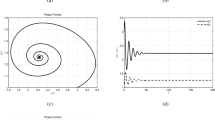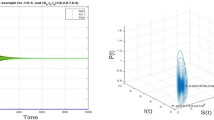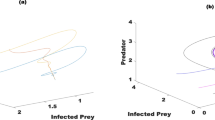Abstract
Predator–prey models are regarded as the structural blocks of the bio- and ecosystems as biomasses are headed by their resource masses. During the current investigation, we examine the impact of a contagious disease on the growth of ecological varieties. We study a non-integer-order predator–prey system by applying the Atangana–Baleanu–Caputo derivative. We use an effective techniqueto get the numerical solutions and to discover the system’s dynamical behavior using different values of fractional order which indicates that how how the proposed scheme is suitable to solve the dynamical systems containing the derivatives with non-singular kernels. Moreover, the existence of the results is given utilizing the fixed-point theorem. Also, diagrams via numerical simulations of the approximate solutions are shown in different dimensions.



























Similar content being viewed by others
Availability of data and materials
No date used in this work.
References
Freedman, H.I.: Deterministic Mathematical Models in Population Ecology, vol. 57. Marcel Dekker, New York (1980)
Murray, J.D.: Mathematical Biology, 3rd edn. Springer, Berlin (2002)
Dubey, B., Upadhyay, R.K.: Persistence and extinction of one-prey and two-predator system. Nonlinear Anal. Model. Control 9(4), 307–329 (2004)
Gakkhar, S., Singh, B., Naji, R.K.: Dynamical behavior of two predators competing over a single prey. BioSystems 90(3), 808–817 (2007)
Kar, T.K., Batabyal, A.: Persistence and stability of a two prey one predator. Int. J. Eng. Sci. Technol. 2(2), 174–190 (2010)
Samanta, G.P.: Analysis of a delay nonautonomous predator–prey system with disease in the prey. Nonlinear Anal. Model. Control 15(1), 97–108 (2010). https://doi.org/10.15388/NA.2010.15.1.14367
Wang, W., Chen, L.: A predator–prey system with stage-structure for predator. Comput. Math. Appl. 33(8), 83–91 (1997). https://doi.org/10.1016/j.mcm.2006.04.001
Bernard, O., Souissi, S.: Qualitative behavior of stages structure d populations: application to structural validation. J. Math. Biol. 37(4), 291–308 (1998). https://doi.org/10.1007/s002850050130
Zhang, X., Chen, L., Neumann, A.U.: Th stage-structured predator–prey model and optimal harvesting policy. Math. Biosci. 168(2), 201–210 (2000). https://doi.org/10.1016/S0025-5564(00)00033-X
Cui, J., Chen, L., Wang, W.: Th effect of dispersal on population growth with stage-structure. Comput. Math. Appl. 39(1–2), 91–102 (2000). https://doi.org/10.1016/S0898-1221(99)00316-8
Cui, J., Takeuchi, Y.: A predator–prey system with a stage structure for the prey. Math. Comput. Model. 44(11–12), 1126–1132 (2006). https://doi.org/10.1016/j.mcm.2006.04.001
Liu, S., Beretta, E.: A stage-structured predator–prey model of Beddington–DeAngelis type. SIAM J. Appl. Math. 66(4), 1101–1129 (2006)
Chattopadhyay, J., Arino, O.: A predator–prey model with disease in the prey. Nonlinear Anal. 36, 747–766 (1999)
Hadeler, K.P., Freedman, H.I.: Predator–prey populations with parasitic infection. J. Math. Biol. 27, 609–631 (1989). https://doi.org/10.1007/bf00276947
Han, L., Ma, Z., Hethcote, H.W.: Four predator prey models with infectious diseases. Math. Comput. Model. 34(7–8), 849–858 (2001). https://doi.org/10.1016/S0895-7177(01)00104-2
Zhou, X., Cui, J., Shi, X., et al.: A modified Leslie–Gower predator–prey model with prey infection. J. Appl. Math. Comput. 33, 471–487 (2010). https://doi.org/10.1007/s12190-009-0298-6
Sweilam, N.H., Khader, M.M., Nagy, A.M.: Numerical solution of two- sided space-fractional wave equation using finite difference method. J. Comput. Appl. Math. 235, 2832–2841 (2011). https://doi.org/10.1016/j.cam.2010.12.002
Duarte, J., Januario, C., Martins, N., Sardanyes, J.: Chaos and crises in a model for cooperative hunting a symbolic dynamics approach. Chaos 19(4), 043102 (2009). https://doi.org/10.1063/1.3243924
Capone, F., Carfora, M.F., De Luca, R., Torcicollo, I.: Turing patterns in a reaction–diffusion system modeling hunting cooperation. Math. Comput. Simul. 165, 172–180 (2019). https://doi.org/10.1016/j.matcom.2019.03.010
Cosner, C., DeAngelis, D., Ault, J., Olson, D.: Effects of spatial grouping on the functional response of predators. Theor. Popul. Biol. 56(1), 65–75 (1999). https://doi.org/10.1006/tpbi.1999.1414
Pal, S., Pal, N., Samanta, S., Chattopadhyay, J.: Effect of hunting cooperation and fear in a predator–prey model. Ecol. Complex. 39, 100770 (2019). https://doi.org/10.1016/j.ecocom.2019.100770
Ryu, K., Ko, W.: Asymptotic behavior of positive solutions to a predator–prey elliptic system with strong hunting cooperation in predators. Phys. A 531, 121726 (2019). https://doi.org/10.1016/j.physa.2019.121726
Sen, D., Ghorai, S., Banerjee, S.M.: Allee effect in prey versus hunting cooperation on predator—enhancement of stable coexistence. Int. J. Bifurc. Chaos 29(6), 1950081 (2019)
Singh, T., Dubey, R., Mishra, V.N.: Spatial dynamics of predator–prey system with hunting cooperation in predators and type I functional response. AIMS Math. 5, 673–684 (2020). https://doi.org/10.3934/math.2020045
Song, D., Song, Y., Li, C.: Stability and turing patterns in a predator-prey model with hunting cooperation and Allee effect in prey population. Int. J. Bifurc. Chaos 30(09), 2050137 (2020). https://doi.org/10.1142/S0218127420501370
Wu, D., Zhao, M.: Qualitative analysis for a diffusive predator–prey model with hunting cooperative. Phys. A 515, 299–309 (2019). https://doi.org/10.1016/j.physa.2018.09.176
Yan, S., Jia, D., Zhang, T., Yuan, S.: Pattern dynamics in a diffusive predator–prey model with hunting cooperations. Chaos Solitons Fractals 130, 109428 (2020). https://doi.org/10.1016/j.chaos.2019.109428
Yavuz, M., Sene, N.: Stability analysis and numerical computation of the fractional predator–prey model with the harvesting rate. Fractal Fract. 4(3), 35 (2020). https://doi.org/10.3390/fractalfract4030035
Hashemi, M.S., PartoHaghighi, M., Bayram, M.: On numerical solution of the time-fractional diffusion-wave equation with the fictitious time integration method. Eur. Phys. J. Plus 134(10), 488 (2019). https://doi.org/10.1140/epjp/i2019-12845-1
Inc, M., Parto-Haghighi, M., Akinlar, M.A., Chu, Y.M.: New numerical solutions of fractional-order Korteweg-de Vries equation. Results Phys. 19, 103326 (2019). https://doi.org/10.1016/j.rinp.2020.103326
Inc, M., Partohaghighi, M., Akinlar, M.A., Agarwal, P., Chu, Y.M.: New solutions of fractional-order Burger–Huxley equation. Results Phys. 18, 103290 (2019). https://doi.org/10.1016/j.rinp.2020.103290
Partohaghighi, M., Ink, M., Baleanu, D., Moshoko, S.P.: Ficitious time integration method for solving the time fractional gas dynamics equation. Therm. Sci. 23(Suppl. 6), 2009–2016 (2019). https://doi.org/10.2298/TSCI190421365P
Ahmad, Zubair, Ali, Farhad, Khan, Naveed, Khan, Ilyas: Dynamics of the fractal-fractional model of a new chaotic system of integrated circuit with Mittag–Leffler kernel. Chaos Solitons Fractals 153, 111602 (2021). https://doi.org/10.1016/j.chaos.2021.111602
Murtaza, S., Kumam, P., Ahmad, Z., Sitthithakerngkiet, K., Ali, I.E.: Finite Difference simulation of fractal-fractional model of electro-osmotic flow of Casson fluid in a micro channel. IEEE Access 10, 26681–26692 (2022). https://doi.org/10.1109/ACCESS.2022.3148970
Ahmad, Zubair, Bonanomi, Giuliano, di Serafino, Daniela, Giannino, Francesco: Transmission dynamics and sensitivity analysis of pine wilt disease with asymptomatic carriers via fractal-fractional differential operator of Mittag–Leffler kernel. Appl. Numer. Math. 185, 446–465 (2023). https://doi.org/10.1016/j.apnum.2022.12.004
Ahmad, Zubair, Arif, Muhammad, Ali, Farhad, Khan, Ilyas, SooppyNisar, Kottakkaran: A report on COVID-19 epidemic in Pakistan using SEIR fractional model. Sci. Rep. 17;10(1), 22268 (2020). https://doi.org/10.1038/s41598-020-79405-9
Ahmad, Z., El-Kafrawy, S.A., Alandijany, T.A., Giannino, F., Mirza, A.A., El-Daly, M.M., Faizo, A.A., Bajrai, L.H., Kamal, M.A.: A global report on the dynamics of COVID-19 with quarantine and hospitalization: a fractional order model with non-local kernel. Comput. Biol. Chem. 98, 107645 (2022). https://doi.org/10.1016/j.compbiolchem.2022.107645
Toufik, M., Atangana, A.: New numerical approximation of fractional derivative with non-local and non-singular kernel: application to chaotic models. Eur. Phys. J. Plus 132, 444 (2017)
Acknowledgements
The authors would like to thank the reviewers for their valuable comments.
Funding
There is no funding.
Author information
Authors and Affiliations
Contributions
All authors have equal contribution.
Corresponding author
Ethics declarations
Ethics approval and consent to participate
There is no ethics issue in this work.
Conflict of interest
There is no conflict of interest.
Additional information
Publisher's Note
Springer Nature remains neutral with regard to jurisdictional claims in published maps and institutional affiliations.
Rights and permissions
Springer Nature or its licensor (e.g. a society or other partner) holds exclusive rights to this article under a publishing agreement with the author(s) or other rightsholder(s); author self-archiving of the accepted manuscript version of this article is solely governed by the terms of such publishing agreement and applicable law.
About this article
Cite this article
Partohaghighi, M., Akgül, A. New Fractional Modelling and Simulations of Prey–Predator System with Mittag–Leffler Kernel. Int. J. Appl. Comput. Math 9, 43 (2023). https://doi.org/10.1007/s40819-023-01523-5
Accepted:
Published:
DOI: https://doi.org/10.1007/s40819-023-01523-5




